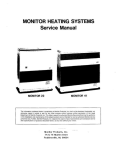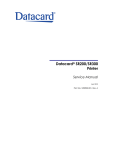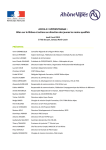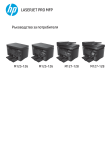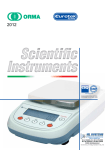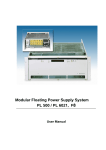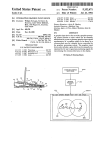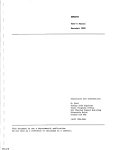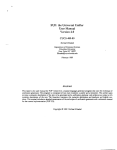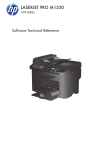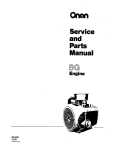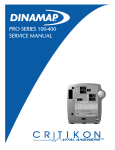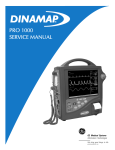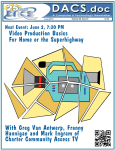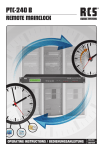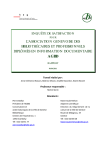Download W-le-Ne-R - W-IE-NE
Transcript
User’s Manual W-Ie–Ne-R VME 430 Cern Spec. Plein & Baus GmbH General Remarks The only purpose of this manual is a description of the product. It must not be interpreted as a declaration of conformity for this product including the product and software. W-Ie-Ne-R revises this product and manual without notice. Differences between the description in manual and the product are possible. W-Ie-Ne-R excludes completely any liability for loss of profits, loss of business, loss of use or data, interrupt of business, or for indirect, special incidental, or consequential damages of any kind, even if W-Ie-Ne-R has been advises of the possibility of such damages arising from any defect or error in this manual or product. Any use of the product which may influence health of human beings requires the express written permission of W-Ie-Ne-R. Products mentioned in this manual are mentioned for identification purposes only. Product names appearing in this manual may or may not be registered trademarks or copyrights of their respective companies. No part of this product, including the product and the software may be reproduced, transmitted, transcribed, stored in a retrieval system, or translated into any language in any form by any means without the express written permission of W-Ie-Ne-R. PROFIBUS if named in this document is replaced by CANbus Mains Voltage and Connection The Power supplies are equipped with a “World”- mains input, which works properly form 94VAC up to 264VAC and within a frequency range of 47 to 63Hz. Before connecting to the mains please double-check correspondence. The mains input connection at the power supply side is done with a 3-pin Hirschmann connector (input current max. 16 A) or power terminals. Hirschmann Pin No. Signal Description Color of the Wire Pin 1 L Phase black or brown Pin 2 N Return, Neutral blue Pin 3 Earth not connected PE Protective Earth green/yellow Safety After connecting the Power box to the mains, the mains input module is powered permanently. Filter and storage capacitors of the power factor correction module are charged with about 400VDC. The DC-On-Signal as well as a power switch at control board (if any installed) operates as a DC on/off switch only and not as a mains breaker. Therefore it becomes dangerous if the box cover is open. In this case a lot of components on high voltage potential get touchable! Before starting any kind of work inside the power box remove the unit from mains and wait a couple of minutes with your activities! Discharge the primary DC Filtercapacitors by use of a well isolated 22 ohm 10W resistor. September 08 Every fan is single controlled by the micro-processor based fan failure and fan speed control mit. Thus a malfunction of any one of the fans is detected. With the FAN SPEED switch the speed of the fans can be step wise reduce or increase . Further, it is possible to switch the fans complete off if the optional crate temperature measurement (at slot 1 position) is installed. In this case the bin temperature is automatically controlled. If the bin temperature reaches the threshold value of 45°C the fans are automatically switched On. For monitoring of fan speed, voltages, currents, temperatures, and optional bin temperature and network address the control and monitoring unit is equipped with a LED - alphanumeric display. In the case of illegal conditions or crate failures it serves as diagnostic system. For the data transfer between fan-tray, bin and power supply based on the RS232 standard (2400 Baud) the free lines 41 and 42 a t PG46PG47 (see wiring scheme) are used. They now correspond to the RS232 TXD and RXD lines. Further, the free lines 8 and 9 a t PG46PG47 are used for the optional bin temperature measurement (at slot 1)and for the SYSFAIL signal respectively. By this way the monitoring and controlling operations are extended by a lot of important functions. By use of an optional possible interface all fan parameters can be monitored and each fan can be single controlled. If using all W-le-Ne-R power supply, fantray and bin, a lot of control functions concerning the power supply are possible too. Optionally several interfaces are available as CAENET, IEC, and PROFIBUS. Thus, remote control from a single point by an IBM-PC or a seperated VME or CAlMAC crate is possible by use of I E C interface CAENET interface PROFIBUS interface for up to 15 crates for up to 99 crates for up to 256 crates. According to the CERN V-430 specification for remote control and monitoring the following signal lines are available a t a monitoring and control connector (CANON Type DAC 15-S-FO)which is placed at the bin backside, WWQ mudfx,ring ~ and oan%ral Description line STATUS FAN FAILURE A.C.POWER INHIBIT SYSRESET OV SIGNAL DISABLE GND status monitor output fan failure output remote on 1off manual system reset common control return line global trip-off disable input ground. STATUS and FAN FAILURE are switched by relais contacts. They are close connected to the return lines in case of correct operation. The system reset circuit is activated by a short circuit between the SYSRESET and the GND signal line. For trouble shooting purposes the global trip-off can be disabled by a jumper connection between INHIBIT and OV SIGNAL lines. I 1.3. VME-fan-tray UEL 4251EC The UEL 425/EC is the W-Ie-Ne-R economic fan tray unit version which conforms the CERN V430 standard. The unit is equipped with 3 axial 2-speed AC-fans. The fans are noise decreased mounted with shafts on ball bearings. SWITCHES main switch for ventilation and power protected located switch for SYSRESET circuit activation P SYS RES F RANGE SEltECT 1 FAN SPEED circular selection switch to choose voltage range 2 position button for fan speed FAN AUTO OFF 1 switch to choose between local and remote warning or d.c. voltage cut-off after fan-failure LED - INDICATORS green large LED lights if PO WER is on green LED lights if all voltages are within the limit yellow LED lights if a fan failure is recognised yellow LED lights if an overheat in the power supply occur SYSFAIL ~ .J red LED lights if VME-bus system generates the SYSFAZL signal (system red control LED for reduced fan speed (approx. 50%) for 'only warning after ; . , ~ ~ ~op+~,::?zz~ $ ~ u ~ ~ ; (red - control ~failure'LED fan mode (d.c. off after fan .... . . . . .............. ........... ...: .:. .....:......:.:.... ................ failure disabled) Sys Res Switch Auto Off Switch and LED Fan Speed Switch and LED - Range select Switch Voltage display Current Display LED's for Status, Fan Fail Overheat and Sys Fail Power LED Power switch Fig.2 UEL 425 EC fan tray front panel User's Manual VME 430 Cern Spec. W-le-Ne-R Plein 8 Baus GmbH As the microprocessor controlled fan tray unit the UEL425lEC can operate in two different modes. In the standard mode the air is taken from the front and then pushed upwards to the modules. A bottom side air inlet for full cooling efficiency can be reached by removing the bottom plate of the fan-tray and mounting an optional front Cover. The maximum air flow reached is greater then 380 m3/h and shows a good homogeneity. Working with front air inlet only a reduced air flow is available. The static pressure is equal to 8 mm water column. With the 2 position FAN SPEED switch the speed of the fans can be reduced. For monitoring of voltages and currents the control and monitoring unit is equipped with a dual digital panel meter. The voltage range can be chosen by a circular selection switch. Al1 elements of the control unit are placed at the front panel of the fan-tray, 1.3. VME-power-supplyUEP 429 The VME-power-supply UEP 429 is a micro-processor controlled switching power supply designed in a high density modular technology. The power supply is placed within the bin in the upper part of the back behind the backplane. It can be removed or inserted easily by the User. The a.c. input voltage is 180-264 V 147-63 Hz whereby the input is protected by a slow-blow fuse 10N250V. A solid state relay comects the power supply to a.c. mains. The relay is activated by the POWER ONIOFF switch mounted at the fan-tray front panel. The VDE 0871 class B rule concerning RFI rejections is accomplished. The insulation performs the CERN V430 specification with input to output 1KV-eff. However, due to the bin - fan-tray and bin - power supply connectors (48 pinRADIALL) required by the CERN V430 specification the ISO NDE norm is not realised. The available voltages with the corresponding maximum available currents are given in the following table [ tem 0370- 0302. H 0370- 0012. H 0370- 0312. H 0370- 0052. H 0370- 0353. H 0371- 0352. H September 08 - - Power cupplies VME- Series 430 UEP 429 CERN 5V1100A +/-I 2Vll OA UEP 429 5V1200A +/-I 2Vll OA UEP 429 5V1300A +I-12Vll OA UEP 429 5V1100A -5,2V1100A -2Vl50(1OO)A +/-I 2V10A UEP 429 5V1200A -5,2V1100A -2V150(1OO)A +/-I 2Vll OA UEP 429 5V1100A -5,2V1100A -2V150(1OO)A +/-I 2Vll OA +/-I 5Vll OA 90-265VAC 90-265VAC 90-265VAC 90-265VAC 90-265VAC 90-265VAC The power output to backplane connections conform to the CEFtN V430 specification, i.e. the high current d.c. power outputs (+5V, -5.2V7-2V and GND) are connected with the backplane bus bar via massive special fork connectors and the low current outputs (+I-12V, +I-15V) as well as the sense, monitoring and control signal lines via a multiway (48-pin RADIALL) connector. Each output rail can be adjusted by a multi-turn potentiometer which is placed a t each power module covered by the top plate, but free accessible. The voltage regulation parameters depends on the module type, i.e. switched or linear regulated module. The static regulation is better than 0.2% or 0.3% for +I100% load change combined with +/_15%mains variation for the switched and the linear regulated modules, respectively. In the case of dynamic regulation the deviation is lower than 0.7% within 0.35 ms for +I-25% load change for the switched module and lower than 0.7% within 0.2 ms for +/_25%load change for the linear regulated one. The periodic and random deviations (PARD) are less than 20 mV(pp) for 20 MHz and 5 mV(pp) for 2 MHz band width, as well as 5 mV(pp) for 20 MHz and 1 mV(pp) for 2 MHz band width for the linear regulated voltage. If the UEP 429 is used in a compatible bin the PARD may be higher but within the CEFtN-specification (<50mV(pp)) By the help of the remote sense lines an output voltage compensation of a t least 0.5 V is possible. An internal 10 ohm resistor is mounted between each sense and power line to avoid a going out of control in the case of external discomected sense lines. Turning on the power supply all voltages reach the nominal values nearly simultaneously within 50+/_2.5ms (start-end-time) whereby the voltage versus time curve shows a monotone behaviour. The start-off-time which corresponds to a value of 10% of the nominal voltages is reached after 2.5+/_2.5ms. The turnon inrush current is limited by a soft start-circuit to a maximum value of 12 A. The UEP 429 shows a n excellent long time stability. Under constant conditions the maximum voltage drift is lower than 10 mV or 0.1% within 24 hours or 50 mV or 1.0% within 6 months. The temperature coefficient of the output voltages is less than 2.0*10-4 /K. To dissipate the heat produced within the power packs two fans are placed in the bottom of the power supply. Al1 monitoring and control operations are performed by a micro-processor based alarm and control circuit which is placed inside the UEP 429. To protect both the power supply and the VME modules, a d.c. cut-off is started in the case of, - overheat in the power modules (each module is equipped with temperature sensors); - overload, i.e. 115% of nominal maximal current is exceeded (trip-off current set to 115% as standard value, can be changed [see 2.2.1); - overvoltage, if voltage >125% (hardware) and if >105% (software, can be changed) - undervoltage, if voltage <97.5% (software, can be changed) - f a n failure. If the d.c. cut-off is started all voltages decrease within a time of 5 ms to a minimum of about 20% of their nominal values (or -lV for the -2V output). For monitoring all voltages and currents as well as the temperature inside the power supply (and fan speed, air entry temperature, and optional parameters, See 1.2) can be shown on the alphanumeric display of the fan-tray. The current information is given by a d.c. output reference voltage which corresponds to the current with a ratio of 1V1100A (+5V, -5.2V, -2V) or 1VIlOA (+I-12V, +/,15V). The display ADC resolution is 10 bit. The accuracy of the voltage measurement is better than 0.5%. The accuracy of the current measurement depends on the corresponding voltage, i.e. for +/_5Vit is better than 2A in the range between 5A - 50A and for -2V it is better than 1A in the range between 1A - 20A. Above these current ranges the accuracy is at least 5% of the final value. In the case of +I-12V and +I-15V the accuracy is better than 0.2 in the whole current range. In addition to the standard VME and CERN V430 specification it is possible to change and adjust the values for current limits (trip off current) as well as for minimum and maximum voltages (see 2.2). Thus, module damages during tests can be preyented. However, this software based feature works only if using together W-le-Ne-R power supply, fan-tray, and bin. For the data transfer between fan-tray, bin and power supply based on the RS232 standard (2400 Baud) the free lines 41 and 42 at PG44 - PG45 (see wiring scheme) are used. They now correspond to the RS232 TXD and RXD lines. By this way the monitoring and controlling operations of the power supply are extended by a lot of important functions. Optional several interfaces for the fan-tray are available as CAENET, IEC, and PROFIBUS. Thus, remote control and operation of the fan-tray and the power supply is possible from a single point (IBM-PC or a separated VME or CAMAC crate, See 1.2.). User's Manual VME 430 Cern Spec. W-le-Ne-R Plein & Baus GmbH 1.5. Technical data Summary BIN UEV 431 Dimension Backplane Weight 483 mm X 8U X 420 mm (whd) 21 slots for 6U VME-system cards multilayer monolith, J l , J 2 , and Ja, (CERN V430) 9.6 Kg FAN-Tray UEL 425 Number of fans Fan type Fan live time Maximum air flow Max. static pressure Control unit Weight 3 SANYO DC San Ace 109P1224H102 60.000 h (at 40 OC) ~ 5 4 m3 0 /h (bottom air inlet) >400 m3 /h (front air inlet) >10mm water column. micro-processor based with alphanumeric display (10 bit ADC) 3.3 Kg FAN-Tray UEL 425 EC Number of fans Fan type Maximum air flow Max. static pressure Control unit Weight September 08 3 Papst 4658N >380 m3 /h (bottom air inlet) >8mm water column. dual digital voltage 1 current panel meter 3.9 Kg 11 User's Manual W-le-Ne-R VME 430 Cern Spec. Plein 8 Baus GmbH I.5 Technical Details of UEP429 Power Supplies Mains input Sinusoidal: CE EN 61000, pow. fact. 0,98 (230VAC), 92 ...264VAC, 16A Inrush current: limited to nominal input current, max. Available modules min. to max. 2... 7V 6... 16V (+I-) Type MEH Type MDH range max. output 100A +15% / 20A +15% I 550W 300W (600W) Regulation (+/-100% load, +/- f~illinains static: MEH 550W1650W range) MDH dyil.: MEH. MDH <0,05% <1 OOinV Recovery time +/-25% load: NIEH / MDH within +-1% within +-0,1% 0,2ms 0,5ms, Sense compensation range: difference between min. and max. output voltage Noise and ripple <1 OmVpp, (0-20MHz ) : <15mV (+I-100% load, +/- full mains range) (+/-25% load) <2mVrms (0-30MHz) Operation temperature range: Temp.-coefficient : Stability (conditions const.): 0....50°C without derating, Storage:-30°C ... +85"C < 0,2% / 1CIK lOmV or 0,1% I 24 hours, 25mV or 0,396 / 6 month Current limits: Voltage rise cliaracteristics: adjustable to any lower level monotonic 50n1s, processor controlled. Protective equipment Overvoltage crow bar : DC Off (trip off): trip off adjusted to 125% of nominal voltage each output within 5nls if >2% deviation from adjusted nominal values, by reason of overload, overheat, over-voltage, under-voltage, (bad status) and fan fail if temperatures exceed 1 10°C heat sink, 70°C ambient Trip off points adjustable, processor controlled. Output capacitors will be discharged by the crow bars if the power supply trips or when switched off. Efficiency : 75% ... 85%, depends on modules / output voltage Life time: DC- Fans: Power Supply electroilics: 25°C ambient >85 00011 40°C >I30 000 h Weight: 14....18kg dependent upon number of fitted modules September 08 40°C >65 000 h 2. Oneratin~instructions 2.1. global operations POWER ONIOFF switch up : switch down : on (green POWER LED lights) off SYSRESET pushing will call a VME-SYSRES, after pushing the display shows 'SYS RES' MODE SELECT switch up : switch down : next mode (UEL 425) previous mode (UEL 425) 7 position switch for voltage range (UEL 425 EC) The red SYS FAIL LED lights up if the SYSFAIL signal is generated by the VME-bus system. This indicator works only if using all together W-le-Ne-R power supply, fan-tray, and bin. On the alphanumeric display in the centre of the fan-tray front panel the values of fan speed, temperatures, voltages and currents as well as the adjusted voltage and current limits will be shown. To choose between the available modes push the MODE SELECT switch. The following table gives a look about all available modes and shows examples for the displayed values. Note that the modes marked by * only will be shown if the optional available network interface (CAENET, IEC. PROFIBUS) and 1 or the bin temperature measurement a t slot 1is installed. ................... ........................................................................................................................................ ................................................................................................................................................ ............... .... . . . . . . . . . ...... :;. ....: ::~ijjjjijj,ijjjjj:j~~:;:),: ,,::ii::;,,:j::::::jjj:i:ji:jj:;:j;;::~::,~jljl:::I:iI:IIII;.~$~ijj~;~~~~ji~:.I, . .... .... ........ ............................................................... ....................................................................... :i::&vai$hb~e:ijM&&@iiand Mode Voltage +5V 5.00 +12V 12.00 +15V 12.00 STBY 5.00 -5V 5.20 -12V 12.00 -15V 15.00 -2V 2.00 FANS 3000 TEMP 25 PTMP 55 BTMP: 35 CAEN* ADDR PROF ADDR IEC* ADDR Ej&&piw Current 100.0 Description +5V channel +12V channel +15V channel ---stand-by channel 80.00 -5.2V channel 6.00 -12V channel 3.00 -15V channel 40.00 -2V channel RPM fan rotation speed "C fan air inlet temp. OC power supply temp. * OC bin slot 1temp. 12 CEANnet addresg* 12 Profibus gddress 12 IECbus address 6.00 3.00 .' 2.2. Fan-tray operations FAN SPEED switch up : switch down : AUTO OFF switch up : switch down : step wise increase of fan speed step wise decrease of fan speed auto off enabled, a fan failure will set off the crate auto off disabled, a fan failure will not set off the crate, only local and remote waniing is given The maximum value of fan speed is up to 3120 rpm. If the speed is lower than 3000 rpm the red SLOW SPEED LED lights. Change of fan speed is possible independently from the displayed mode. If another range of the display was set before pushing the FAN SPEED switch the display shows the speed for 5 sec. and returns back to the previous range. The display shows the nominal speed of the blowers and twinkles if it differs from the given real speed. The yellow FAN FMLURE LED lights in the case of any fan-failure. Power-supplymonitoring and control operations All present voltage and current values of the several voltage output lines as well as the temperature inside the power supply can be shown on the alphanumeric display of the fan-tray. To select between the display modes push the MODE SELECT switch as given in 2.2. Using both W-le-Ne-R power supply and fan-tray it is also possible to adjust the controlling limits of the power supply. The values of the minimum and maximum output voltage and the maximum current which cause a cut-off can be changed according to the following instructions, 1. Switch on fan-tray and select channel (e.g.+12V) with MODE SELECT switch. 2. Switch up both POWER and MODE SELECT switches together for about 5 sec. Then the controlling mode menu including selected channel, limit (starting with IOFF), and the corresponding value will be shown on the display. 3. Choose the type of limit (trip-off current: IOFF, minimum voltage: UMIN, and maximum voltage: UMAX) by pushing the MODE SELECT switch 4. Switch up POWER until the value twinkles. 5. Change the value by pushing the MODE SELECT switch down (value will decrease) or up (value will increase). 6. To accept the new value switch down POWER. The power supply control unit is programmed indicated by flashing PROG. To change the other limits repeat step 3 - 6. 7. Switch POWER down to end programming. Note that all control limits are stored within the power supply control unit which is located inside the power supply. During programming all remote control signals will be ignored. 2.4. Error message list Both, w - i e - ~ e - r tpower supplies and fan-trays are equipped with microprocessor based monitoring and control units. Thus, any fan or power module failure will be detected and on the alphanumeric display an error message is shown. This is a usefd information for trouble shooting. 2.4.1 Error messages during self test after switching on Fan-Trav failures CHKS CONF Configuration check sum error CHKS UCAL Check sum error of calibration voltage CHKS ZCAL Check sum error of calibration current PROM CONN internal CPU error CHKS ADDR Check sum error of network address C H m STAT Check sum error of previous mains onloff status CHKS FAN Fan-tray check sum error Power supplv failures P S PROM CHKS Power supply check sum error Pushing SYSRES the first three error messages will be ignored, but keep in mind the defective conditions especially, for the voltage and current monitoring. The other errors, instead of the CPU error are automatically corrected so that the error message serves only as information for the User. 2.4.2 Run time error messages FAN OFF Fan failure TEMP OFF Temperature of power supply too high AC FAIL Failure of a.c. power (line) +/_??VOV Overvoltage of channel +/_??V +/-??V W Undervoltage of channel +/-??V +/-??V OC Overcurrent of channel +/_??V 2.5. Change of air flow direction The UEL 425 fan-tray can operate in two different modes. The standard fan takes the air from the front and pushes it upwards to the modules. To reach full cooling efficiency through a bottom side air inlet remove the bottom plate and change the front cover plate according to the following instructions: 1. Release all screws of the fan-tray bottom plate and remove it. 2. Release the screws fixing the front plate of the fan-tray and remove front grid placed behind the front plate 3. Insert front cover plate (optional) and fix all screws. 3. Test sheef! A.1. Scheme of crate dimensions A.2. Principe diagram A.3. Wiring diagram A.4. J l , J 2 , J„ pin allocation table and position scheme B. Summaw data sheet U m m m 2 g, 2 0 E W L C z' U = L Lm 0 a Cr N V W W L :: C-i ,2 - X 0 I L L I D F- L Tc W 'J n3 Ci3 L L 0 a TI \T cn - L P - W 3 0 n3 Ir- Ir -- g- E C - > a N I L j a. a. r- C m a Y lndur s u r e ~ U m m Ln 3 m , noU d L m m oom- W L U W L -- > I UriUW CCOU OOLC U E ari hCt P - m m -p > L n 4)OjUO + L ~OU6JlIOJ7UO~ U 6 > 0 m N ---7 U Y C m m C L W r i o U 4 L m m o o u 1 L U W Y- UOUIK n C o m m w L L U C Y L z m m L c + m I m U L L a O L. O ~ 6 oxtl 0x1 1 IOJJUQ3 -- PlIJl Pin Nwnbcr Row B Row A Row C Pin Niimbcr Row A 1 Row i3 Row C W8 D@ D10 D11 D12 D13 D14 D15 2 3 4 5 6 7 8 U x r Dciincd U x r Dciined Uscr Dciincd Uscr Dciincd Uscr Dciincd Uscr Dciincd Uscr Dciincd Uscr Dcfincd +5 VDC GND (I) RESEKVED A24 A25 A26 A27 A2S Uscr Dciined U x r Dciincd Uscr Dcfincd Uscr Dcfincd Uscr Dciincd Uscr Dciincd Uscr Dcfincd User Dcfincd BG20UT* BG31N' BG30UT' BRO* BRl* BR?* BR3' AM0 GND SYSFAL* BERR* SYSRESET* LWORD* AM5 A23 A22 9 10 11 12 13 14 15 16 Uscr k f i n c d Uscr Dciincd Uscr DcGncd Uscr Dcfined Uxr Dciin~i Uscr Dciincd Uscr Dcfincd Uscr Dciincd A29 A30 A31 GND +5 VDC D16 D17 D18 U x r Dcfincd User Dcfincd Uscr Dcfined Uccr Defincd Uscr Dcfincd Uscr Dcfincd Uscr Drfinul Uscr Dcfirilil GND AS* GND IACK* IACKIN* IACKOUT* AM4 A07 AMI AM2 AM3 GND ( t t ) SERCLK (tt)SERDAT* GND IRQ7 * A21 AZO Al9 Al8 Al7 Al6 Al5 AI4 17 18 19 20 21 22 23 24 (Jscr Dcfiricd Uscr Dciincd Uscr Dciincd User Dciincd Uscr Dcfincd Uscr Dciincd User Dciincd Uscr Dcfincd D19 D20 D2 1 D22 D23 GND D24 D25 Uscr h i i r i c d U.xr Dcfiiicd Uscr Dcfincd Uccr Dcfincd Uscr Dcfined User Dciincd U x r Dciincd Uscr Dcfiiicd AM A05 AM A03 A02 A01 -12 VDC +5 VDC IR@* RQS* Al3 Al2 Al 1 Al0 A09 A08 +I2 VDC +5 VDC 25 26 27 28 29 30 31 32 Uscr Dciincd Uscr Dcfincd Uscr D c i i n d User Dcfincd Uscr Dcfincd Uscr k f i n c d User Dciincd Uscr Dcfincd D26 D27 D28 D29 D30 D3 1 GND +5 VDC User Dcfincd IJscr Dcfincd U.xr Dcfincd U.xr D c f i n d Uscr Dcfincd Uscr Dcfinui Uxr kfincd Uscr Dcfincd 1 2 3 4 5 6 7 8 D00 D01 Da2 W3 DO-2 D05 D06 D07 BBSY* BCLR* ACFAL* BGOIN* BGWW* BGIIN* BG I O U T BG2IN' 9 10 11 12 13 14 15 16 GND SYSC1.K GND DSI* DSO* WKITE* GND DTACK* 17 18 1Y 20 21 22 23 24 25 26 27 28 29 30 31 32 mw* IRQ3' IRQ2' IRQI* +5VSTDBY + 5VDC ' Nuics: ( t j RESERVED was n d c f i n c d a s REi'RY*, and (tt) SERCLK SERDAT* wcrc ch:mgcd io iiscr dcfincd pins in ~ h Kcvision c D VhlEbus spwificaiioii. Jaux Pin Number 1 2 3 4 5 6 7 8 Row A SN1 SN3 SN5 CK* SG* CL* -2v -15V Row B GND GND GND GND GND GND - 2v CE A.4. J l , J 2 , Ja- pin allocation table Row C SN2 SN4 GND CK SG CL -2v +15V
























